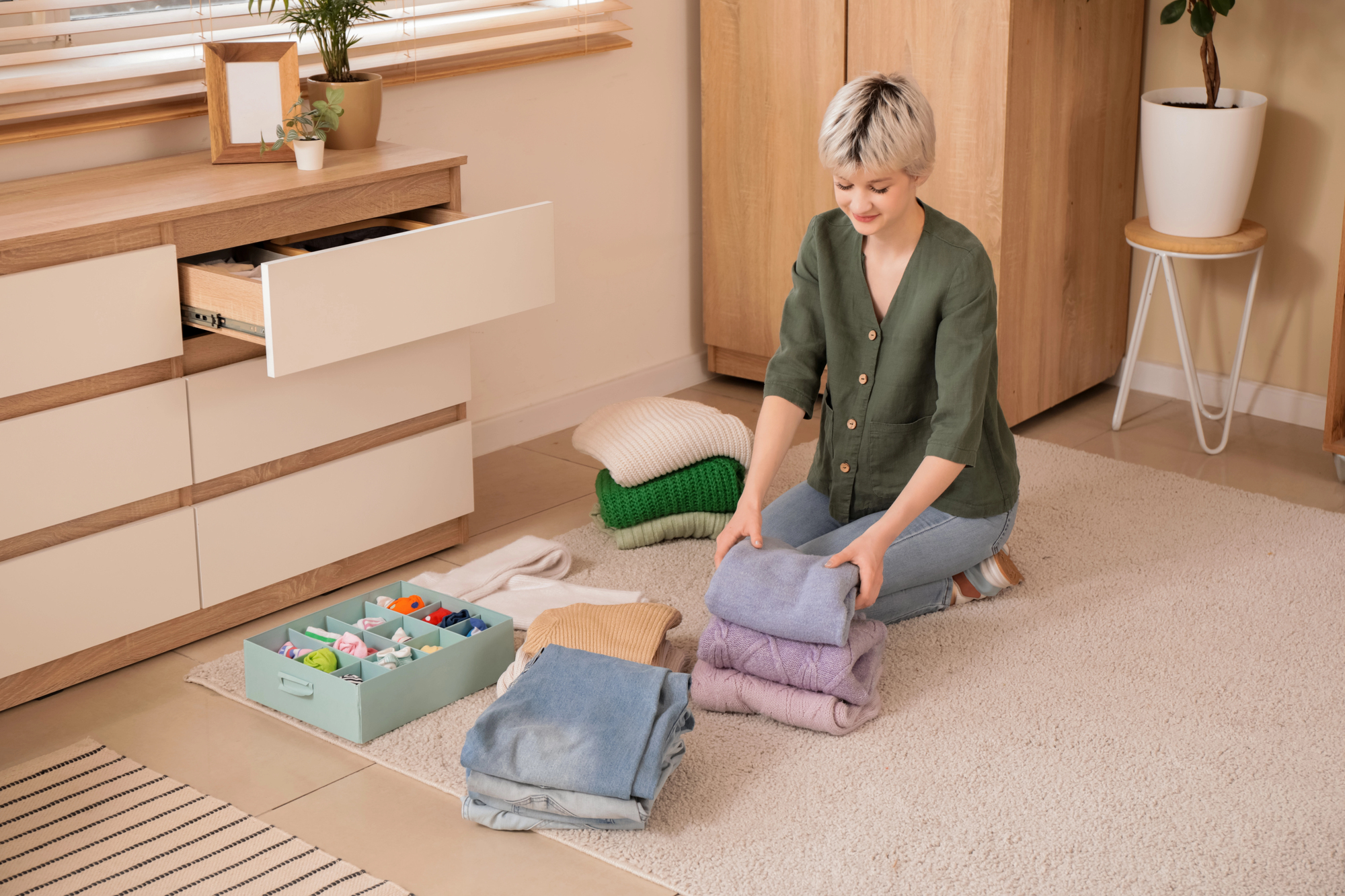30-Day Guide to Decluttering Your Home
Life Photo / 14 February 2025

How To Declutter Your Home in 30 Days
Whether you’re always losing stuff or you just want more free space in your home, there are many good reasons to declutter. Keeping an organized living space can benefit you in more ways than you might think.
Clutter in a home can have a significant negative impact on mental health and well-being. It creates feelings of stress, anxiety, and overwhelm. A disorganized environment can serve as a constant visual distraction, affecting your focus and making your living space feel chaotic.
Most household clutter builds up over time, so you can’t expect to get rid of it all overnight. However, it’s possible to organize your home and improve your quality of life in 30 days if you create and follow the right plan.
Importance of Decluttering Your Home
It’s easy to procrastinate when it comes to household chores, but decluttering your home can significantly improve your quality of life. A clutter-free environment promotes mental clarity and reduces stress, enabling you to focus and feel more relaxed.
Decluttering can also lead to increased productivity, as you spend less time searching for misplaced items and more time engaging in activities that matter. With less mess in your home, you’ll be able to comfortably accommodate guests in a space you’re proud to show off.
Fully decluttering your home can seem daunting, especially if you’re dealing with a large accumulation of stuff. The process can become even more exhausting if you don’t have a clear plan in place. This often leads to frustration and further procrastination.
Many people struggle when deciding which things to keep and which to throw away. It can be difficult to part with items that have sentimental value. Time constraints and busy lifestyles can further complicate your cleaning plans, and make it seem easier to avoid it altogether. The good news is that decluttering your home can be made easy if you start with a realistic plan and break the work up into manageable pieces.
30-Day Decluttering Tips
With the right plan, you can make your decluttering journey as smooth and painless as possible. Creating a 30-day timeline can help you avoid getting overwhelmed and keep you feeling motivated as you accomplish incremental goals. Several important elements should be included in an effective decluttering plan.
Day 1: Set Clear Decluttering Goals
Setting decluttering goals for each room in your house starts with assessing the space and identifying specific areas that need attention. Create a checklist for each room, breaking down the decluttering process into smaller tasks.
Establish a timeline for completing these tasks. Set realistic deadlines to keep you motivated. You can choose to focus on one category at a time, such as clothing, books, or kitchen items, or target particular zones like closets, drawers, or surfaces.
You can help keep yourself on track by using a planner to outline your individual decluttering goals and the daily tasks required to accomplish them. By dividing the work up into more manageable tasks and establishing a reasonable timeline for those tasks, you can make it easier to achieve your decluttering goals and ultimately create a more organized home environment.
Day 2: Organize With a Custom Plan
It’s important to develop a decluttering plan that suits your unique needs. If your plan isn’t tailored to your schedule and priorities, it can be much harder to achieve your ultimate goals within 30 days.
Using a custom calendar to plan your work in advance can help balance your decluttering goals with your personal and professional commitments for each week, and avoid any scheduling conflicts that may stall your journey.
Finding dedicated time to declutter can be difficult, but by mapping out a detailed 30-day schedule on your monthly calendar, you can identify the most convenient times to clean your home and complete the work in a way that doesn’t interfere with the other aspects of your life.
When you create your cleaning schedule, it’s often helpful to prioritize individual cleaning tasks that will have a larger impact on your daily life, and address these tasks first. For example, decluttering your bedroom can increase ventilation in the space and help enhance sleep quality. This can improve how you feel daily and help motivate you to stay on track.
If you live with family members, partners, or roommates, it may also be helpful to create a shared or family calendar that outlines when each resident must clean their personal living space. This helps ensure that your home remains clutter-free and teaches others about the value of organization.
Days 3–7: Focus on High-Traffic Areas
Starting with high-traffic areas when decluttering your home is beneficial because these spaces tend to accumulate the most clutter and can have the greatest impact on your daily life. Clutter in high-traffic areas, such as entryways, living rooms, and kitchens, where you and your family spend a lot of time can create a sense of chaos and disorganization.
By tackling these zones first, you can quickly restore functionality and a sense of order, which can motivate you to continue decluttering other areas of your home. Additionally, clearing out high-traffic spaces can improve the overall flow of your living environment, making it more inviting and comfortable for both you and your guests.
Days 8–14: Tackle Closets and Storage Spaces
Closets and storage spaces are often the first places where clutter begins to accumulate in a home, so it’s important to address these areas early in your process. Designating separate storage containers for specific categories of items in your closets (shoes, jewelry, etc.) can effectively reduce clutter and make it easier to find items when you need them.
Along with categorizing items by type or function, you can use storage solutions like clear bins, labels, and dividers to maximize closet space and enhance visibility. You should also consider vertical storage solutions like shelves and hooks to take advantage of underutilized areas.
Days 15–21: Address Paper Clutter
Creating a system to manage paper clutter is a crucial aspect of organizing your home. While most of the paper clutter you sift through may be trash, some documents may contain important or sensitive information, and it’s important to handle these items accordingly.
Categorizing documents into essential groups such as bills, important records, and items to shred or recycle helps you protect your sensitive information and avoid losing anything important.
After you’ve discarded all the unimportant papers, utilize physical filing solutions such as filing cabinets, binders, and folders to store necessary documents securely and efficiently. To ensure important documents are easy to locate, designate different storage solutions for different types of papers like bills, tax documents, work materials, and keepsakes.
Days 22–28: Purge Unnecessary Items
Deciding which items to keep when cleaning your home can be a daunting task, so it often helps to follow a systematic approach. Start by assessing the utility and sentimental value of each item; ask yourself how often you use it and whether it truly adds value to your life. Implement a "one-year rule" — if you haven't used an item in the past year, it's likely that you won't miss it in the future and should let it go.
You should also be considerate of the emotional connection you have with certain items — if they bring joy or serve a meaningful purpose, they may deserve a spot in your home. You can streamline this process by organizing items into "keep," "donate," and "discard" piles. Ultimately, strive to create a space that reflects your current lifestyle and makes you feel comfortable, focusing on quality over quantity.
Day 29: Track Your Decluttering Progress
Tracking your progress when decluttering your home is essential because it helps maintain motivation and focus throughout the process. As decluttering can be overwhelming, seeing tangible results provides a sense of accomplishment and reinforces your commitment to organizational goals.
Using a journal or photo journal to document your progress allows you to identify patterns, celebrate small victories, and set realistic targets for areas still needing attention. These opportunities to mark your accomplishments and reflect on your daily progress can help keep you motivated as you work.
Progress tracking can also reveal what strategies are working effectively and which ones might need adjustment, ultimately leading to a more efficient and satisfying decluttering experience.
Days 30: Stay Consistent and Celebrate Small Wins
Consistency is key when completing a 30-day decluttering plan, but it can be difficult to stay motivated and regularly finish tasks. Fortunately, you can avoid stagnating by adhering to a comprehensive schedule and taking time to congratulate yourself as you complete individual decluttering tasks.
There are a variety of simple ways to mark your progress and keep yourself focused while you clean. Just the act of checking off boxes in your planner as you complete tasks like cleaning out a closet or organizing a drawer can make decluttering more gratifying. It helps you feel a greater sense of pride in your accomplishments, ultimately leading to a more efficient and satisfying experience.
How To Maintain an Organized Home After 30 Days
Keeping your home clean and organized is an ongoing effort that doesn’t end once you’ve completed the 30-day decluttering process. To maintain an organized home, it’s important to continue practicing smart cleaning habits consistently.
You can help prevent clutter from building up in your home again by assessing items every few months and donating or discarding ones that no longer serve a purpose. Additionally, adopting a "one in, one out" rule, where you remove an item for each new one you bring in, helps to control the amount of possessions in your home over time.
Another helpful technique is to designate specific places for each item in your home and ensure that everything is returned to its designated space after use. Furthermore, creating daily cleaning habits, such as making the bed or tidying up common areas at the end of each day, contributes significantly to maintaining an orderly environment. By incorporating these strategies into your routine, you can cultivate a serene and clutter-free home.


